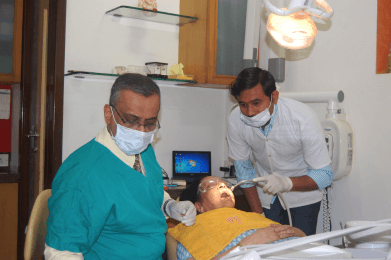Oral Surgery
Extractions
Indications
- Highly mobile tooth/teeth affected by gum disease
- Grossly destructed tooth/teeth
- Wisdom tooth/teeth which are impacted
- Fractured tooth/teeth which are not restorable
- Tooth/teeth associated with cysts or tumors
- Crowded teeth for space creation
- Teeth along fracture line
- Supernumerary (additional) tooth/teeth

Procedure
After conducting a thorough history followed by measurement of vitals, the patient is administered with local anesthesia, to ensure painless and comfortable removal of teeth.
The extraction can either be a simple extraction or a surgical extraction.
Special instruments are used to luxate/ move the tooth and then finally remove it.
The tooth is removed with utmost care by applying minimal pressure and ensuring that minimal trauma is inflicted on the tissues.
Certain complications like infection, bleeding or swelling may arise, but are manageable. Post extraction bleeding can be controlled by application of a medicated cotton gauze that helps in formation of a blood clot in the socket.
Wisdom Tooth Removal
Indications
- Impacted 3rd molars
- Malaligned third molars
- Grossly decayed 3rd molars
- Pain/swelling in the 3rd molar region
- Preventive/prophylactic removal of malaligned 3rd molars

Procedure
After a routine history and vital signs examination the patient is administered local anesthesia for painless surgery. The third molar, being in the innermost area on the jaw, an incision or a cut in the gums is necessary to remove this tooth.
After giving a proper cut, with proper antisepsis and medicaments, the impacted tooth is exposed in the oral cavity. The tooth is removed with the help of specialized dental instruments.
The supplementary medicines and the local anesthesia help ensure that the whole treatment procedure is painless.
Stiches are given to close the open flaps, which are removed after a week.
A regular follow up is taken, to keep a check on post-operative healing.
Sinus Lift Surgery
Indications
- Bone loss arising due to long standing non – replacement of missing teeth in the posterior maxilla
- Inadequate height of bone to place the implant in the upper back segment
Procedure
Sinus lift surgery is a procedure to elevate the maxillary sinus to augment bone to facilitate the placement of a dental implant in the posterior maxilla. It can be carried out in cases where the existing bone is deficient to carry out implant placement.
Diagnostics like Panoramic radiographs like Orthopantomograph (OPG) and a Cone Beam CT (CBCT) scan are done to measure the sinus height and width and to rule out any sinus disease/ pathology.
The procedure is performed intra-orally wherein the dentist will reflect the gum tissue and using specialized instruments and equipments painlessly elevate the sinus membrane. The space thereby created is filled with bone regenerative graft material to increase the height of bone. Depending on the treatment planned, immediate or delayed implant placement is done thereafter to functionally restore the patients missing tooth.
